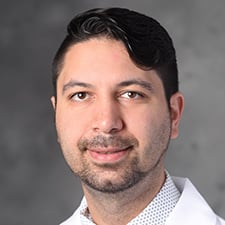A novel procedure that inserts tiny valves into the lungs to improve functionality is giving patients with chronic obstructive pulmonary disease (COPD) a new lease on life. Over the last two years, Henry Ford Health System has emerged as a leader in this procedure, making it possible for patients to escape COPD’s grip and recapture their daily routines.
COPD is the third leading disease-related cause of death in the United States, according to the American Lung Association. Inhalers are a common modality for treating COPD, allowing patients to go about their daily activities. The most extreme approach is lung transplant, when a patient reaches the end stage of disease. There haven’t been any “in between” interventions, said Avi Cohen, MD, a Henry Ford interventional pulmonologist.
Bronchoscopic lung-volume reduction is designed to fill this gap, helping patients who aren’t sick enough to need a transplant but require something stronger than an inhaler. The procedure was initiated at Henry Ford in 2019, and to date more than 150 of the procedures have been conducted across the health system.
Henry Ford is a member of the AMA Health System Program, an initiative to advance leadership and offer enterprise solutions to drive the future of medicine.
Targeting lung’s weakest areas
The procedure targets the “obstructive” component of COPD through strategic valve insertion. The valves essentially create a one-way exit to get air out of the lungs. The Food and Drug Administration has approved several brands of these valves.
Clinicians select the “sickest” lobe of the lung that isn’t doing much to help the patient breathe but is causing the most problems. The valves allow air to escape from that trapped lung, taking pressure off the diaphragm, noted Dr. Cohen. The valves are installed during a 30-minute procedure. Patients stay in the hospital for a few days to monitor for complications.
Many insurers cover this procedure as a gold standard treatment, noted Dr. Cohen. “Sometimes we’ve had to go through appeals. We haven’t had any procedures canceled because insurance wouldn’t cover it.”
“It gets them going”
COPD patients often find it difficult to take out the trash, walk to the mailbox, even make their beds. The novel valve procedure revolutionizes their quality of life, said Dr. Cohen. “It gets them going. They exercise more, they gain more strength. They can go through pulmonary rehab more effectively.”
For one Michigan farmer in his early 60s, it helped reclaim his independence.
Once very active, the patient’s lung function started to deteriorate after years of smoking cigarettes. He found Dr. Cohen’s team through a Facebook group and signed up for the valve procedure. Waking up in recovery, the patient felt as though a snake wrapped around his neck had unleashed its grip. He could breathe comfortably.
He's since been able to take care of his farm and is less reliant on family and friends. He also kicked a bad habit. “One of the procedure requirements was he had to quit smoking four months beforehand,” said Dr. Cohen.
Rigorous selection process
Not all COPD patients may be eligible for the procedure. Patients must be willing to go the extra mile to improve their quality of life, said Dr. Cohen.
A procedure only goes so far, he added. “We’re able to provide them with the tools, but if they don’t choose to exercise more with the ability of the valve they may not gain too much from it.”
Everyone goes through an assessment. People who can’t tolerate general anesthesia due to severely injured lungs from smoking or who are too healthy, are not good candidates. “We do rigorous testing to see which lobe is the best one to go after. We target the part of the lung that’s not participating much and seal it off.”
Dr. Cohen and colleagues want to explore other uses in patients with obstructive lung disease or asthma. “But it’s still too early to think about that,” he said.
Find out how Henry Ford is moving telehealth forward with the virtual exam kit.




